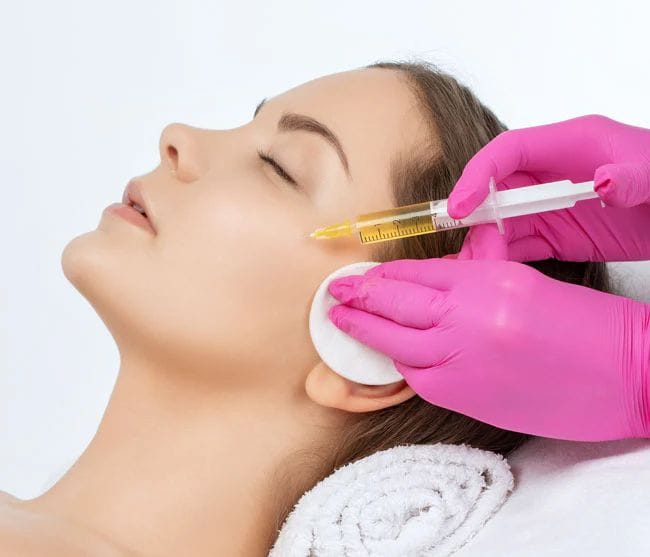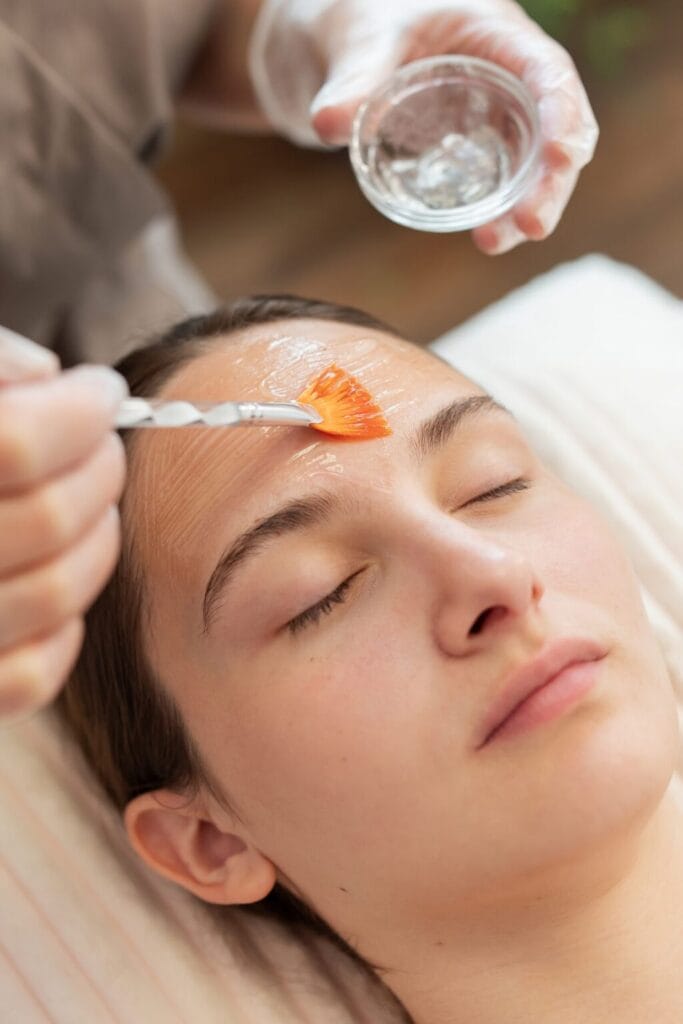Platelet-Rich Plasma (PRP) facial treatment has emerged as a popular cosmetic procedure that enhances skin rejuvenation by using your body’s natural healing components. Known as the “vampire facial,” this therapy involves extracting blood, isolating platelet-rich plasma, and reinjecting it into the skin to improve texture, tone, and reduce wrinkles. PRP is a versatile treatment used in dermatology, plastic surgery, and cosmetic medicine. Whether PRP is used alone or combined with microneedling, the results of PRP treatment continue to gain attention due to its regenerative effects and minimal downtime.
What is PRP Facial Treatment?
A PRP facial treatment is a non-surgical cosmetic procedure that utilizes platelet-rich plasma (PRP) derived from the patient’s blood to rejuvenate facial skin. This facial involves PRP injections targeting areas with wrinkles, poor skin texture, and signs of aging. Treatments use a patient’s plasma combined with hyaluronic acid to hydrate and heal the facial skin. The PRP procedure has gained popularity for its natural approach to anti-aging treatment and is often called the vampire facial.
Understanding Platelet-Rich Plasma
Platelet-rich plasma is a concentration of platelets suspended in plasma, extracted using a centrifuge to separate it from other blood components. PRP contains a high level of growth factors which help stimulate collagen production and accelerate healing in a specific area. The use of platelet rich plasma in dermatology has expanded due to its effectiveness in skin healing and facial rejuvenation treatment.
How PRP Injection Works
A PRP injection involves drawing a small amount of blood, spinning it in a centrifuge, and then injecting the platelet-rich plasma into targeted skin areas. The growth factors in PRP promote regeneration, making it an effective treatment option for facial rejuvenation. PRP injections are administered carefully to the treatment area by trained dermatology or cosmetic professionals.
What to Expect During PRP Therapy
PRP therapy begins with a consultation and treatment plan tailored to your skin’s needs. After blood is drawn and PRP is prepared, the practitioner will inject PRP into the skin using fine needles. You may feel slight discomfort, and minor bruises may appear temporarily. The whole PRP appointment typically lasts about 45 minutes.
What are the Benefits of PRP Facial Treatment?
The main benefit of PRP facial treatment is its ability to naturally stimulate skin regeneration and collagen production. This effective treatment addresses issues like fine lines, dull tone, and early signs of aging. PRP is given without foreign chemicals, making it suitable for those seeking holistic cosmetic treatments.
Enhancing Skin Texture and Tone
PRP facial therapy significantly improves skin texture and tone by stimulating natural cell turnover. It helps diminish discoloration, roughness, and promotes smoother facial skin. According to research, PRP treatment improved overall skin quality in multiple treatments.
Effectiveness in Reducing Fine Lines and Wrinkles
PRP injections reduce the appearance of fine lines and wrinkles by increasing hydration and boosting collagen. PRP can also firm sagging skin and soften deep wrinkles, especially when paired with microneedling. Wrinkles and fine lines fade progressively after each session in a series of treatments.
Stimulating Collagen Production
One of PRP’s greatest strengths is its ability to stimulate collagen naturally. Collagen production slows with age, but growth factors in PRP reignite the process. Studies on PRP show it can enhance skin elasticity and promote youthful facial contours. Stimulate collagen without invasive plastic surgery or dermal filler.
How Does PRP Work for Facial Rejuvenation?

PRP works for facial rejuvenation by activating fibroblasts, stimulating tissue repair, and increasing blood flow. It triggers wound healing and new skin cell growth. Since PRP contains concentrated platelets and proteins, it supports facial skin rejuvenation without harming the surrounding tissue.
The Role of Growth Factors in PRP
Growth factors in PRP play a key role in cell regeneration, vascularization, and skin repair. These proteins accelerate skin healing, reduce inflammation, and enhance collagen synthesis. Use PRP for natural skin rejuvenation based on your body’s healing potential.
Did You Know?
Growth factors in PRP can also aid in hair growth and treat hair loss conditions
How PRP Affects Skin Regeneration
PRP promotes skin regeneration by increasing cell turnover and reducing oxidative stress. It boosts skin hydration and promotes youthful tissue density. The PRP rejuvenation process continues for weeks after the treatment session.
Combining PRP with Microneedling
Combining PRP with microneedling amplifies the results of PRP therapy by creating microchannels in the skin. This allows deeper penetration of PRP into the dermis, maximizing the effects of facial rejuvenation. Use microneedling with PRP to enhance collagen production and treat scars and enlarged pores.
Who is a Good Candidate for PRP Facial Treatment?
Most healthy adults are candidates for PRP facial treatments, especially those experiencing early aging signs, dull skin, or minor scars. However, a medical conditions screening is required before beginning therapy.
Assessing Medical Conditions
Conditions like clotting disorders, autoimmune diseases, or active skin infections may disqualify you from PRP therapy. Always consult a certified dermatology specialist before starting your treatment plan.
Age and Skin Type Considerations
PRP is suitable for various age groups and skin types. Younger patients may benefit from preventive care, while older individuals can target wrinkles and sagging. Hyaluronic acid on skin facial rejuvenation treatments may complement PRP for dry or aging skin.
Understanding Risks and Benefits
While PRP is safe, common side effects include mild swelling or bruise at the injection site. Knowing the benefits and risks helps set realistic expectations for treatment outcomes.
What Should You Expect After PRP Facial Treatment?
After a PRP facial, expect minor redness and swelling that subside within 1–3 days. Downtime is minimal compared to more invasive cosmetic treatments.
Downtime and Recovery Process
The downtime after a PRP facial is usually short. You can return to normal activities within a day or two, though it’s recommended to avoid direct sun and strenuous activity temporarily.
Results of PRP Treatment Over Time
The results of PRP treatment become noticeable over several weeks, improving with each session. Long-term improvement is possible with regular follow-up treatments.
Did You Know?
Clinical trials on PRP facial rejuvenation show consistent improvement in fine lines and skin texture.
Follow-up Treatments and Maintenance
A series of treatments may be necessary to achieve full results. Most experts recommend 3–4 sessions spaced a month apart, followed by maintenance every 6–12 months depending on your treatment area.
How to Prepare for Your PRP Facial Treatment?

Start with a consultation to create a personalized treatment plan tailored to your facial needs. This ensures your PRP therapy aligns with your goals.
Consultation and Treatment Plan
During consultation, your skin will be evaluated, and your treatment area identified. The specialist will design a treatment plan that fits your skin type and concerns.
Pre-Treatment Guidelines
Avoid alcohol, blood thinners, and anti-inflammatory medications a week before the procedure. This helps reduce bruising and ensures effective platelet concentration.
What to Avoid Before the Procedure
To minimize side effects, avoid smoking, excessive sun exposure, and skincare acids right before treatment. Proper preparation enhances the potential of PRP.
Did You Know?
The “vampire facial” got its name due to the use of your own blood and its rejuvenating effect on skin.
Frequently Asked Questions about PRP Facial Treatment
What are the benefits of PRP for the face?
PRP facial treatment offers multiple benefits such as improving skin texture, reducing fine lines, stimulating collagen, and enhancing hydration. Additionally, PRP supports tissue regeneration and brightens dull complexions without introducing foreign substances. It’s ideal for patients who want natural rejuvenation without surgery or harsh chemicals.
How long do PRP facial results last?
PRP facial results typically last between 6 to 12 months, depending on your skin type, age, and lifestyle. Maintenance treatments every few months help prolong the youthful glow. Regular skincare, hydration, and avoiding sun exposure are essential to maintain the effect.
How much does PRP face treatment cost?
The cost of PRP facial treatment ranges between $400 to $1500 per session, depending on the clinic, location, and whether it’s combined with microneedling or other therapies. Some aesthetic clinics offer packages with multiple sessions at a discounted rate.
Is a PRP facial worth it?
Yes, for many people PRP is worth it due to its natural healing process, long-term effects, and minimal downtime. Results look subtle and build gradually, which is ideal if you want to avoid drastic changes or synthetic fillers.
In the ever-evolving field of cosmetic dermatology, PRP facial treatments stand out as a natural, effective solution for facial rejuvenation. By tapping into your body’s healing powers, PRP can improve your skin texture, stimulate collagen, and reduce wrinkles without surgery or artificial fillers. If you’re curious whether PRP may be the right treatment for your skin concerns, consult a qualified provider and get PRP done under professional guidance.
✨ Have you ever tried a vampire facial or considered microneedling? Share your experience and let others know how you take care of your skin
Read also about Intense Pulsed Light